The Smart Nervous System for Cracked Concrete Structures: Theory, Design, Research, and Field Proof of Monolithic DFOS-Based Sensors
Abstract
:1. Introduction
1.1. Structural Safety
- ageing infrastructure [3], which is many years old and in a technical condition problematic for correct assessment,
- new engineering structures with unusual geometry, construction technologies or material solutions for which there is a lack of common experiences.
1.2. Distributed Measurements of Concrete
- The possibility of analysis of the structural behaviour from a real zero stress-strain state (usually, conventional gauges are installed within existing structures with the unknown initial level of stress and deformation).
- Integration inside the structure (concrete) provides a more accurate transfer of the measured physical quantity from the structure to the sensor (no additional mounting brackets or installation methods are needed).
- Natural protection of the embedded sensors against mechanical damages, aggressive external environmental or direct sunlight. The expected operation lifetime of such a system should be comparable with the operation lifetime of the structure itself.
1.3. DFOS Techniques (Data Loggers)
- Rayleigh scattering [23] is used to measure the strains in optical fibre, which are caused both by mechanical and thermal loads. It provides the best spatial resolution, starting from the mm range [24] (1000 measurement gauges per 1 m of the linear sensor), which is particularly useful when analysing localised events like cracks. Moreover, dynamic readings with a frequency of up to 250 Hz are also possible [25]. However, the main limitation of that approach lies in a measurement distance range limited to 100 m (while keeping the high spatial resolution).
- Brillouin scattering [26,27] is used to measure the strains in optical fibre, which are caused both by mechanical and thermal loads. It provides multiple lower spatial resolution (from 20 to 100 cm) compared to Rayleigh scattering. On the other hand, it allows the measurements to be performed over very long distances (e.g., 25 km or more). This makes it suitable for monitoring linear structures like tunnels, roads, embankments, dams or mining and landslide areas.
- Raman scattering [28,29] is used to measure the temperature profile in optical fibre so that it could be used as one of the compensation solutions for Rayleigh and Brillouin measurements. Standard spatial resolution starts from 50 cm, while distance ranges from 25 km and more. This approach can be successfully used as a thermo-detection method [30] to localise fires or leakages.
1.4. DFOS Sensing Tools
- alkaline concrete environment degrades the polyimide coating even after 14 days, while no influence is observed on the acrylate one [34] (that is why polyimide coatings are not advised for long-term measurements of concrete structures).
2. Design of DFOS-Based System for Cracked Concrete
2.1. Main Objectives
- qualitative analysis: cracks’ detection and location (Figure 4a);a significant limitation of spot techniques for crack measurements is that they can be used only when the presence and the position of the crack are known. Knowledge about the location of the crack is not necessary during distributed sensing because its detection is one of the system’s objectives. The possibility of crack detection was checked and confirmed in much research, e.g., [44,45,46]. However, this does not mean that the effectiveness of each DFOS system is unconditional and absolute.
- cracks’ width estimation (Figure 4b);knowledge about the crack’s presence and location is necessary but insufficient for assessing structural safety. The DFOS system should provide information about the actual width of the crack (mm), changing over time, which could be compared to the thresholds defined in relevant standards to answer the question about the crack’s significance for load capacity or durability. The measured strain profile in the close vicinity of the crack should be converted into the crack width (in the literature called also crack opening displacement COD) with reasonable accuracy, useful from a practical point of view (not worse than 0.05 mm). A few procedures are presented in the literature [47,48,49,50], taking into account applied spatial resolution and the assumed physical model of the entire system (also internal design of the DFOS tool).
2.2. Selection of DFOS Technique
2.3. Design of DFOS Tools
- High accuracy ensured by unambiguous strain transfer from the structure to the measuring fibre inside the DFOS tool. This feature is characteristic of a monolithic cross-section of the sensor without any intermediate layers, which disturb measurements by extensive slippage. The lack of slippage within the sensor itself allows for reducing uncertainties and simplifying mathematical models used for strain transfer analysis and crack width calculation;
- High strain range allowing for undisturbed readings of crack-induced deformations without fear of damaging the sensor’s components. Fast-yielding materials like steel or plastic tend to remember the localised historical strains rather than reflect the actual deformation state of the structure. This is especially dangerous during long-term monitoring while cyclic loads are expected;
- Rough outer surface of the sensor must provide the best possible bonding with the surrounding concrete, not only through the adhesion but also mechanical clamping (similar to the reinforcing bars). For instance, it could be done by ribs, braids or perforated grooves [52];
- Resistance to harsh conditions, which are expected during the construction and operation of civil engineering structures. The design of the sensor must provide appropriate protection against mechanical damages, local transverse forces (e.g., pressure of aggregate grains or mounting elements), alkaline concrete environment and other aggressive factors;
- High durability provided by appropriate material. As the sensors are usually fully integrated within the concrete, the expected operation lifetime should be equal to the lifetime of the structure itself;
- DFOS tools cannot require pretension, as this process in construction or geotechnical conditions is challenging or often impossible. Selected stiffness of the sensor’s core must ensure correct positioning without extensive waving, as deviations from the designed position will result in additional errors during data interpretation. Reliable readings must be possible both in the tension and compression zone;
- Prove the sensors’ high performance in at least tens of engineering projects.
2.4. Installation Methods
- the maximum bonding surface between the sensor and the surrounding concrete (from three sides instead of one in case of surface installation);
- natural protection against mechanical damages;
- significant reduction of thermal influence (direct sunlight) on strain results;
- the beast aesthetics without mounting elements visible on the surface.
2.5. Thermal Compensation
- Using the strain DFOS sensors with a Raman-based optical datalogger, which is insensitive to mechanical loads and thus, allows only for temperature measurements; DTS (distributed temperature sensing). This solution is primarily dedicated to long distances (km order).
- Using the strain sensors with both Rayleigh-based and Brillouin-based optical datalogger. These two techniques are depended on mechanical strains and temperatures to varying degrees. Knowing the individual coefficients for each technique, it is possible to solve a system of equations in which the unknowns are mechanical strains and temperatures [31]. It is worth noticing that there are already hybrid data loggers available on the market that use different optical phenomena in their design.
- Using special DFOS temperature sensors and one from DFOS techniques for strain measurements (Rayleigh or Brillouin). The idea behind this solution is to isolate the measuring optical fibre from mechanical strains, for instance, by placing it inside the tube. The fibre is then, apparently, subjected only to temperature changes. However, the free fibre does not exist because of the friction between the tube and the fibre. It can cause disturbances in the measured temperature profiles, especially considering longer distances. In addition, high mechanical strains expected while monitoring the cracks in concrete can consume excess fibre inside the tube.
- Using conventional spot temperature gauges and approximating the temperature field between the measurement points. That approach is justified when no high gradients over length are expected (like in underground installations or other horizontal sections with similar conditions over the entire length).
2.6. System’s Design—Summary
3. Laboratory Tests
3.1. The Concept and Preparation of the Specimens
- C1: sensing cable with three plastic layers (Ø2.8 mm, E = unknown).
- M1: monolithic, reinforcing sensor (Ø5.0 mm, E = 50 GPa)
- M2: monolithic, flexible sensor (Ø3.0 mm, E = 3 GPa)
- C2: sensing cable with two plastic layers and steel insert (Ø3.2 mm, E = unknown).
3.2. Course of the Study and Measurements
3.3. Compression—Example Results
3.4. Tension—Example Results
3.5. Findings
4. Field Proofs
4.1. Railway Bridge near Frankfurt, Germany
4.2. Largest Concrete Cable-Stayed Bridge in Poland
4.3. Renovated Sewage Collector in Poland
- before GRP modules were provided inside the collector (zero reading),
- after the GRP modules were placed (before grout injection),
- after grout (mortar) injection,
- and finally, after the collector was put back into service and filled with sewage.
5. Conclusions
Author Contributions
Funding
Institutional Review Board Statement
Informed Consent Statement
Data Availability Statement
Acknowledgments
Conflicts of Interest
References
- EN 1990:2002; Eurocode: Basis of Structural Design. European Committee for Standardisation: Brussels, Belgium, 2002.
- Faber, M.H. Statistics and Probability Theory in Pusuit of Engineering Decision Support; Springer: Berlin/Heidelberg, Germany, 2012; ISBN 978-94-007-4055-6. [Google Scholar]
- Frangopol, D.; Tsompanakis, Y. Maintenance and Safety of Aging Infrastructure; CRC Press: Boca Raton, FL, USA, 2014; ISBN 978-04-292-2058-6. [Google Scholar]
- Balageas, D.; Fritzen, C.P.; Güemes, A. Structural Health Monitoring; Wiley-ISTE: New York, NY, USA, 2006; ISBN 978-1-905-20901-9. [Google Scholar]
- Xu, Y.L.; Xia, Y. Structural Health Monitoring of Long-Span Suspension Bridges; Spon Press: London, UK, 2012; ISBN 9781138075634. [Google Scholar]
- Kim, B.; Min, C.; Kim, H.; Cho, S.; Oh, J.; Ha, S.-H.; Yi, J.-H. Structural Health Monitoring with Sensor Data and Cosine Similarity for Multi-Damages. Sensors 2019, 19, 3047. [Google Scholar] [CrossRef] [PubMed] [Green Version]
- Howiacki, T. Analysis of Cracks in Concrete Structures with the Use of Distributed Optical Fibre Measurements. Ph.D. Thesis, Faculty of Civil Engineering, Cracow University of Technology, Kraków, Poland, 2022. [Google Scholar]
- Buda-Ożóg, L.; Zięba, J.; Sieńkowska, K.; Nykiel, D.; Zuziak, K.; Sieńko, R.; Bednarski, Ł. Distributed fibre optic sensing: Reinforcement yielding strains and crack detection in concrete slab during column failure simulation. Measurement 2022, 195, 111192. [Google Scholar] [CrossRef]
- Di Sante, R. Fibre Optic Sensors for Structural Health Monitoring of Aircraft Composite Structures: Recent Advances and Applications. Sensors 2015, 15, 18666–18713. [Google Scholar] [CrossRef]
- Bednarski, Ł.; Sieńko, R.; Grygierek, M.; Howiacki, T. New Distributed Fibre Optic 3DSensor with Thermal Self-Compensation System: Design, Research and Field Proof Application inside Geotechnical Structure. Sensors 2021, 21, 5089. [Google Scholar] [CrossRef]
- Siwowski, T.; Rajchel, M.; Howiacki, T.; Sieńko, R.; Bednarski, Ł. Distributed fibre optic sensors in FRP composite bridge monitoring: Validation through proof load tests. Eng. Struct. 2021, 246, 113057. [Google Scholar] [CrossRef]
- Amanzadehab, M.; Aminossadatia, S.M.; Kizil, M.S.; Rakićb, A.D. Recent developments in fibre optic shape sensing. Measurement 2018, 128, 119–137. [Google Scholar] [CrossRef] [Green Version]
- Liu, Y.; Li, X.; Li, H.; Fan, X. Global Temperature Sensing for an Operating Transformer Based on Raman Scattering. Sensors 2020, 20, 4903. [Google Scholar] [CrossRef]
- Hill, D. Distributed Acoustic Sensing (DAS): Theory and Applications. In Frontiers in Optics; Optica Publishing Group: San Jose, CA, USA, 2015. [Google Scholar] [CrossRef]
- Sieńko, R.; Bednarski, Ł.; Howiacki, T. Smart Composite Rebars based on DFOS Technology as Nervous System of Hybrid Footbridge Deck: A Case Study. In European Workshop on Structural Health Monitoring. EWSHM 2020. Lecture Notes in Civil Engineering; Rizzo, P., Milazzo, A., Eds.; Springer: Berlin/Heidelberg, Germany, 2021; Volume 128. [Google Scholar] [CrossRef]
- NERVE Composite DFOS Sensors. Available online: http://nerve-sensors.com (accessed on 22 September 2022).
- Pise, N.; Meshram, T.; Doijad, Y.; Gathe, R.; Bobade, A.; Kutemate, A.; Patil, S.; Raut, P.; Gudadhe, A. A Brief Study on Causes of Cracks, Prevention and Pattern of Cracks on Concrete. Int. J. Sci. Res. Sci. Eng. Technol. 2021, 8, 439–443. [Google Scholar] [CrossRef]
- Jędrzejewska, A.; Kanavaris, F.; Zych, M.; Schlicke, D.; Azenha, M. Experiences on early age cracking of wall-on-slab concrete structures. Structures 2020, 27, 2520–2549. [Google Scholar] [CrossRef]
- Zych, M. Degree of external restraint of wall segments in semi-massive reinforced concrete tanks: Part II: Rectangular and cylindrical segments. Struct. Concr. 2018, 19, 3. [Google Scholar] [CrossRef]
- Kulpa, M.; Howiacki, T.; Wiater, A.; Siwowski, T.; Sieńko, R. Strain and displacement measurement based on distributed fibre optic sensing (DFOS) system integrated with FRP composite sandwich panel. Measurement 2021, 175, 109099. [Google Scholar] [CrossRef]
- Barrias, A.; Casas, J.R.; Villalba, S. Application study of embedded Rayleigh based Distributed Optical Fiber Sensors in concrete beams. Procedia Eng. 2017, 199, 2014–2019. [Google Scholar] [CrossRef] [Green Version]
- Imai, M.; Igarashi, Y.; Shibata, M.; Miura, S. Experimental study on strain and deformation monitoring of asphalt structures using embedded fiber optic sensor. J. Civ. Struct. Health Monit. 2014, 4, 209–220. [Google Scholar] [CrossRef]
- Coscetta, A.; Catalano, E.; Cerri, E.; Oliveira, R.; Bilro, L.; Zeni, L.; Cennamo, N.; Minardo, A. Distributed Static and Dynamic Strain Measurements in Polymer Optical Fibers by Rayleigh Scattering. Sensors 2021, 21, 5049. [Google Scholar] [CrossRef] [PubMed]
- Sang, A.K.; Froggatt, M.E.; Kreger, S.T.; Gifford, D.K. Millimeter resolution distributed dynamic strain measurements using optical frequency domain reflectometry. Proc. SPIE 2011, 7753, 432–435. [Google Scholar] [CrossRef]
- Luna—Optical Distributed Sensor Interrogator. Available online: https://lunainc.com/product/odisi-6000-series (accessed on 22 September 2022).
- Bao, X.; Chen, L. Recent Progress in Brillouin Scattering Based Fiber Sensors. Sensors 2011, 11, 4152–4187. [Google Scholar] [CrossRef]
- Hong, C.Y.; Zhang, Y.F.; Li, G.W.; Zhang, M.X.; Liu, Z.X. Recent progress of using Brillouin distributed fiber sensors for geotechnical health monitoring. Sens. Actuators A Phys. 2017, 258, 131–145. [Google Scholar] [CrossRef]
- Wang, W.; Chang, J.; Lv, G.; Wang, Z.; Liu, Z.; Luo, S.; Jiang, S.; Liu, X.; Liu, X.; Liu, Y. Wavelength dispersion analysis on fiber-optic Raman distributed temperature sensor system. Photonic Sens. 2013, 3, 256–261. [Google Scholar] [CrossRef]
- Muanenda, Y.; Oton, C.J.; Di Pasquale, F. Application of Raman and Brillouin Scattering Phenomena in Distributed Optical Fiber Sensing. Front. Phys. 2019, 7, 155. [Google Scholar] [CrossRef]
- Yan, B.; Li, J.; Zhang, M.; Zhang, J.; Qiao, L.; Wang, T. Raman Distributed Temperature Sensor with Optical Dynamic Difference Compensation and Visual Localization Technology for Tunnel Fire Detection. Sensors 2019, 19, 2320. [Google Scholar] [CrossRef] [Green Version]
- Kishida, K.; Yamauchi, Y.; Guzik, A. Study of Optical Fibers Strain-Temperature Sensitivities Using Hybrid Brillouin-Rayleigh System. Photonic Sens. 2014, 4, 1–11. [Google Scholar] [CrossRef] [Green Version]
- Falcetelli, F.; Rossi, L.; Di Sante, R.; Bolognini, G. Strain Transfer in Surface-Bonded Optical Fiber Sensors. Sensors 2020, 20, 3100. [Google Scholar] [CrossRef] [PubMed]
- Li, D.; Ren, L.; Li, H. Mechanical Property and Strain Transferring Mechanism in Optical Fiber Sensors. In Fiber Optic Sensors; Yasin, M., Harun, S.W., Arof, H., Eds.; InTechOpen: London, UK, 2012. [Google Scholar] [CrossRef] [Green Version]
- Bremer, K.; Alwis, L.S.M.; Zheng, Y.; Weigand, F.; Kuhne, M.; Helbig, R.; Roth, B. Durability of Functionalized Carbon Structures with Optical Fiber Sensors in a Highly Alkaline Concrete Environment. Appl. Sci. 2019, 9, 2476. [Google Scholar] [CrossRef] [Green Version]
- Barrias, A.; Casas, J.R.; Villalba, S. A Review of Distributed Optical Fiber Sensors for Civil Engineering Applications. Sensors 2016, 16, 748. [Google Scholar] [CrossRef] [PubMed] [Green Version]
- Schenato, L. A Review of Distributed Fibre Optic Sensors for Geo-Hydrological Applications. Appl. Sci. 2017, 7, 896. [Google Scholar] [CrossRef] [Green Version]
- Soga, K.; Luo, L. Distributed fiber optics sensors for civil engineering infrastructure sensing. J. Struct. Integr. Maint. 2018, 3, 1–21. [Google Scholar] [CrossRef]
- Weisbrich, M.; Holschemacher, K. Comparison between different fiber coatings and adhesives on steel surfaces for distributed optical strain measurements based on Rayleigh backscattering. J. Sens. Sens. Syst. 2018, 7, 601–608. [Google Scholar] [CrossRef]
- Sieńko, R.; Zych, M.; Bednarski, Ł.; Howiacki, T. Strain and crack analysis within concrete members using distributed fibre optic sensors. Struct. Health Monit. 2018, 18, 1510–1526. [Google Scholar] [CrossRef]
- Bado, M.S.; Casas, J.R.; Kaklauskas, G. Distributed Sensing (DOFS) in Reinforced Concrete members for reinforcement strain monitoring, crack detection and bond-slip calculation. Eng. Struct. 2021, 226, 111385. [Google Scholar] [CrossRef]
- Li, Q.; Li, G.; Wang, G. Effect of the plastic coating on strain measurement of concrete by fiber optic sensor. Measurement 2003, 34, 215–227. [Google Scholar] [CrossRef]
- Kania, J.; Sørensen, K.K. A Static Pile Load Test on a Bored Pile Instrumented with Distributed Fibre Optic Sensors. In Proceedings of the International Symposium on Field Measurements in Geomechanics, Rio de Janeiro, Brazil, 16–20 July 2018. [Google Scholar]
- Barkanov, E.; Akishin, P.; Namsone-Sile, E. Effectiveness and Productivity Improvement of Conventional Pultrusion Processes. Polymers 2022, 14, 841. [Google Scholar] [CrossRef] [PubMed]
- Imai, M.; Feng, M. Sensing optical fiber installation study for crack identification using a stimulated Brillouin-based strain sensor. Struct. Health Monit. 2012, 11, 501–509. [Google Scholar] [CrossRef]
- Barrias, A.; Casas, J.R.; Villalba, S. Embedded Distributed Optical Fiber Sensors in Reinforced Concrete Structures—A Case Study. Sensors 2018, 18, 980. [Google Scholar] [CrossRef] [PubMed] [Green Version]
- Liu, T.; Huang, H.; Yang, Y. Crack Detection of Reinforced Concrete Member Using Rayleigh-Based Distributed Optic Fiber Strain Sensing System. Adv. Civ. Eng. 2020, 2020, 8312487. [Google Scholar] [CrossRef]
- Fischer, O.; Thoma, S.; Crepaz, S. Distributed fiber optic sensing for crack detection in concrete structures. Civ. Eng. Des. 2019, 1, 97–105. [Google Scholar] [CrossRef]
- Alj, I.; Quiertant, M.; Khadour, A.; Grando, Q.; Terrade, B.; Renaud, J.-C.; Benzarti, K. Experimental and Numerical Investigation on the Strain Response of Distributed Optical Fiber Sensors Bonded to Concrete: Influence of the Adhesive Stiffness on Crack Monitoring Performance. Sensors 2020, 20, 5144. [Google Scholar] [CrossRef]
- Kwak, H.-G.; Song, J.-Y. Cracking analysis of RC members using polynomial strain distribution function. Eng. Struct. 2002, 24, 455–468. [Google Scholar] [CrossRef]
- Rodríguez, G.; Casas, J.R.; Villaba, S. Cracking assessment in concrete structures by distributed optical fiber. Smart Mater. Struct. 2015, 24, 035005. [Google Scholar] [CrossRef] [Green Version]
- Tang, Y.; Wang, Z.; Song, M. Self-sensing and strengthening effects of reinforced concrete structures with near-surfaced mounted smart basalt fibre-reinforced polymer bars. Adv. Mech. Eng. 2016, 8, 10. [Google Scholar] [CrossRef] [Green Version]
- Bastianini, F.; Di Sante, R.; Falcetelli, F.; Marini, D.; Bolognini, G. Optical Fiber Sensing Cables for Brillouin-Based Distributed Measurements. Sensors 2019, 19, 5172. [Google Scholar] [CrossRef] [Green Version]
- Sieńko, R.; Bednarski, Ł.; Howiacki, T. Smart prestressed concrete girders with integrated composite distributed fibre optic sensors (DFOS): Monitoring through all construction stages. In Proceedings of the 10th International Conference on Structural Health Monitoring of Intelligent Infrastructure, Porto, Portugal, 30 June–2 July 2021. [Google Scholar]
- Sieńko, R.; Bednarski, Ł.; Howiacki, T. Crack shape coefficient: Comparison between DFOS tools used for crack monitoring in concrete. Sensors, 2022; abstract accepted. [Google Scholar]
- Barrias, A.; Rodriguez, G.; Casa, J.R. Application of distributed optical fiber sensors for the health monitoring of two real structures in Barcelona. Stucture Infrastruct. Eng. 2018, 14, 967–985. [Google Scholar] [CrossRef]
- Biliszczuk, J.; Barcik, W.; Onysyk, J.; Toczkiewicz, R.; Tukendorf, A.; Tukendorf, K. Rędziński Bridge in Wrocław—the largest concrete cable-stayed bridge in Poland. Struct. Eng. Int. 2014, 24, 285–292. [Google Scholar] [CrossRef]
- Biliszczuk, J.; Hawryszków, P.; Teichgraeber, M. Structural Health Monitoring System of a Concrete Cable-Stayed Bridge. Archit. Civ. Eng. Environ. 2018, 11, 69–77. [Google Scholar] [CrossRef] [Green Version]
- Popielski, P.; Bednarz, B.; Sieńko, R.; Howiacki, T.; Bednarski, Ł.; Zaborski, B. Monitoring of Large Diameter Sewage Collector Strengthened with Glass-Fiber Reinforced Plastic (GRP) Panels by Means of Distributed Fiber Optic Sensors (DFOS). Sensors 2021, 21, 6607. [Google Scholar] [CrossRef] [PubMed]

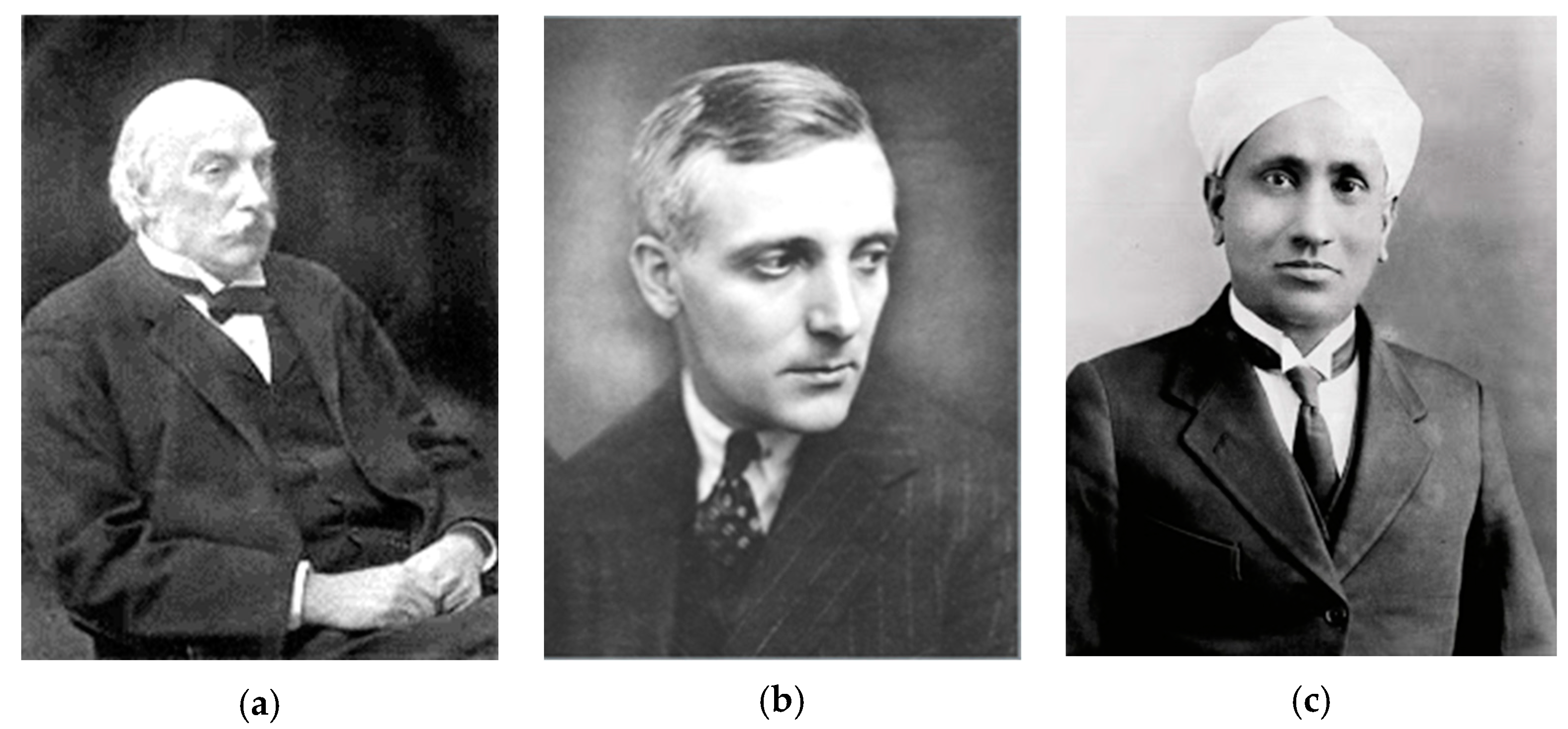
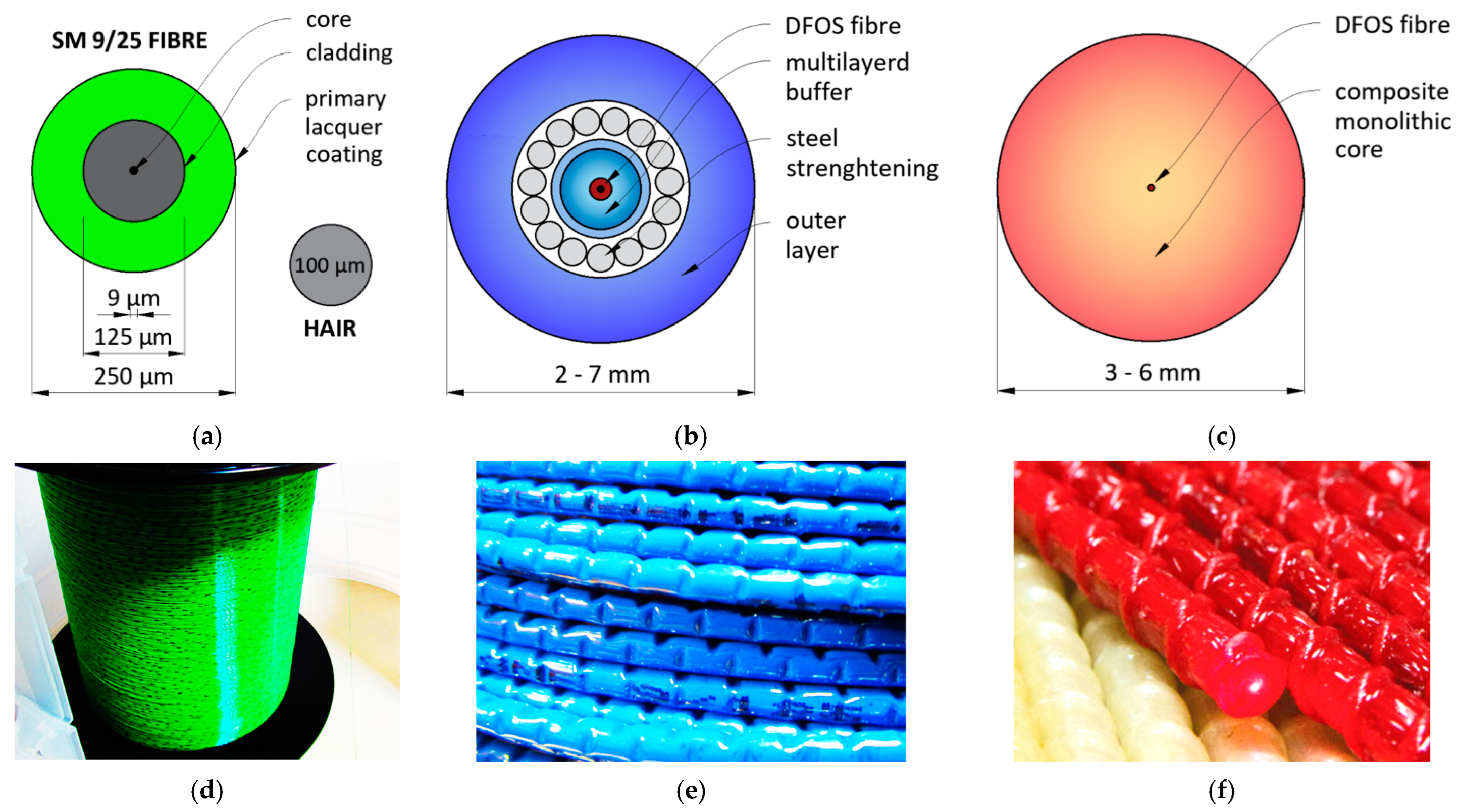

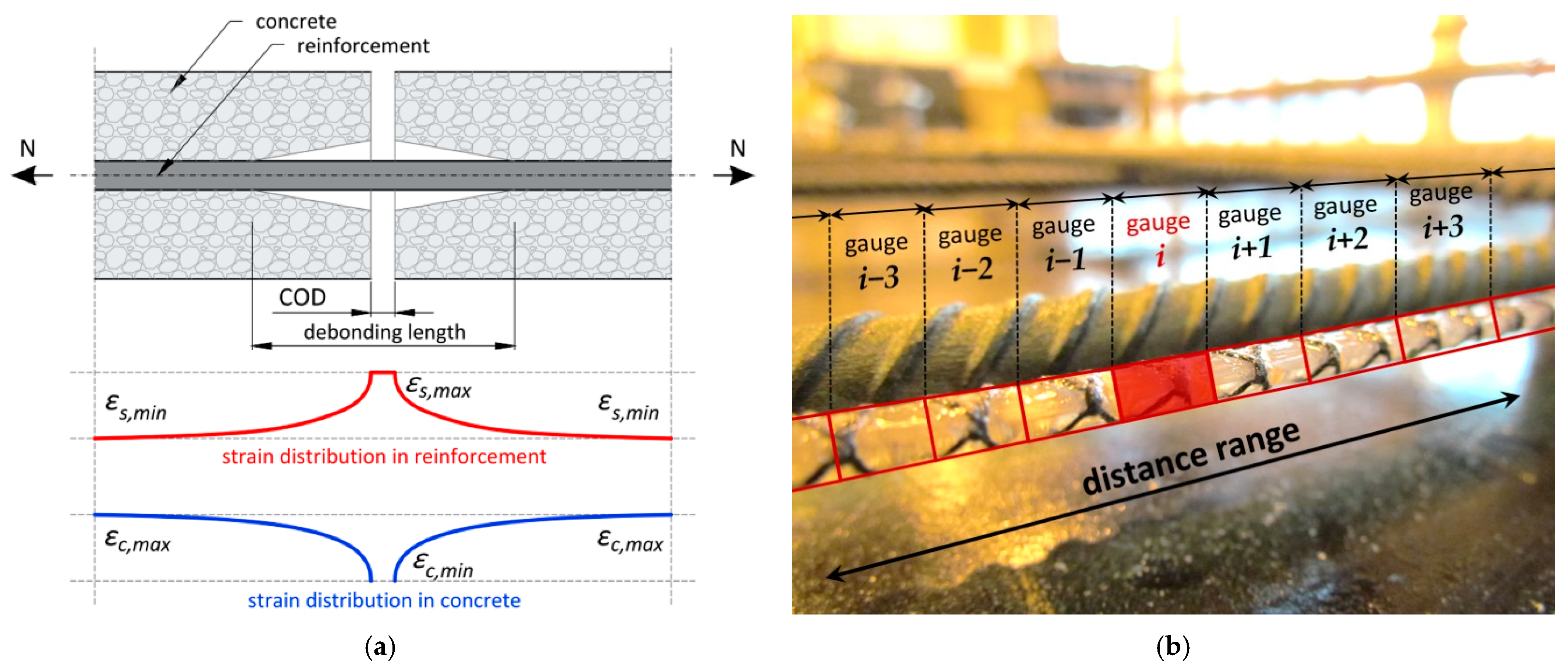
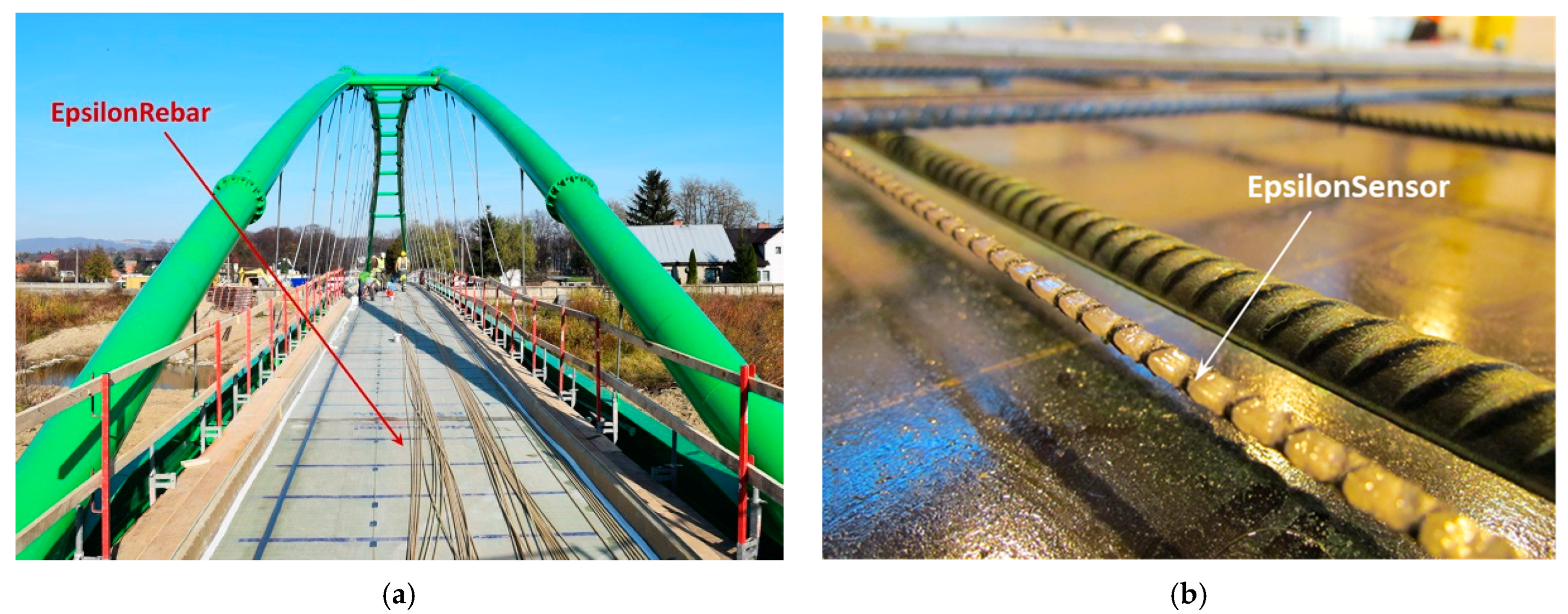





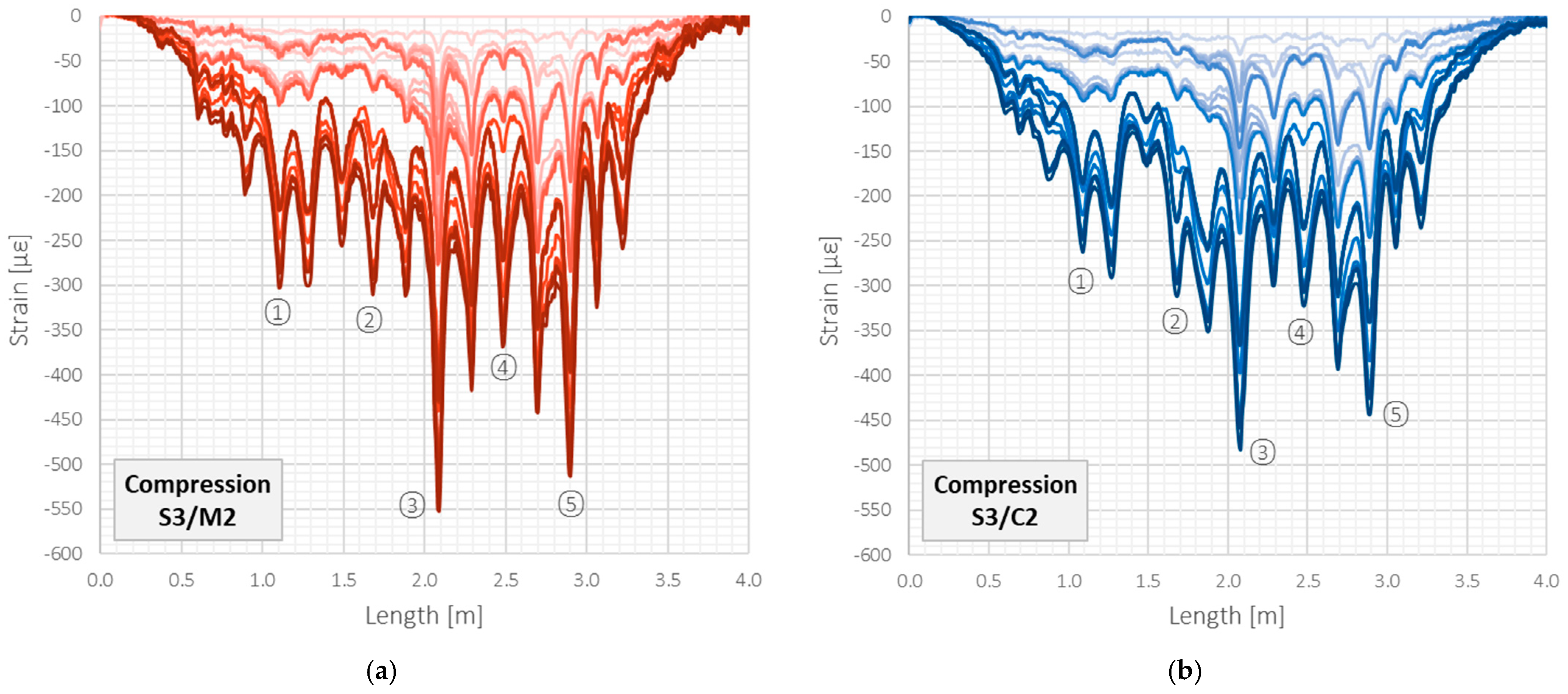

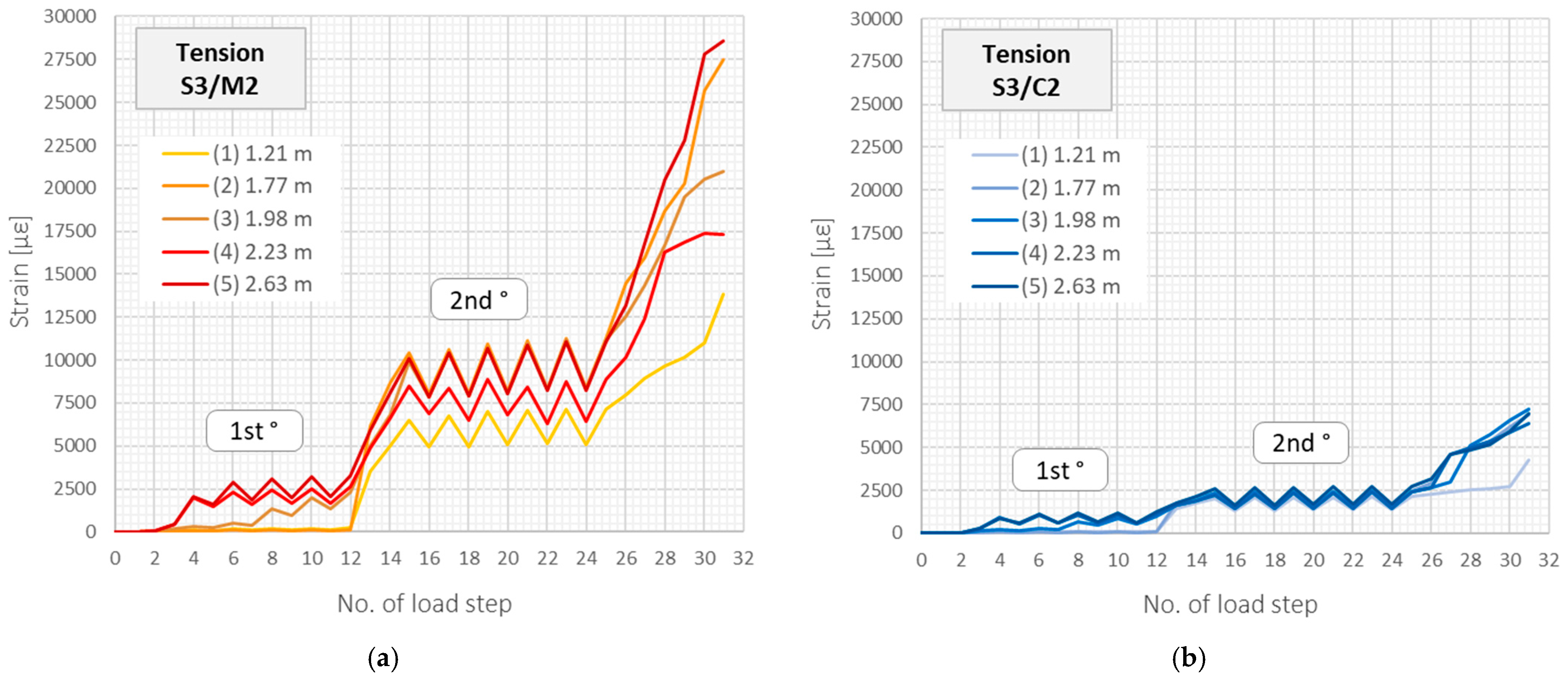




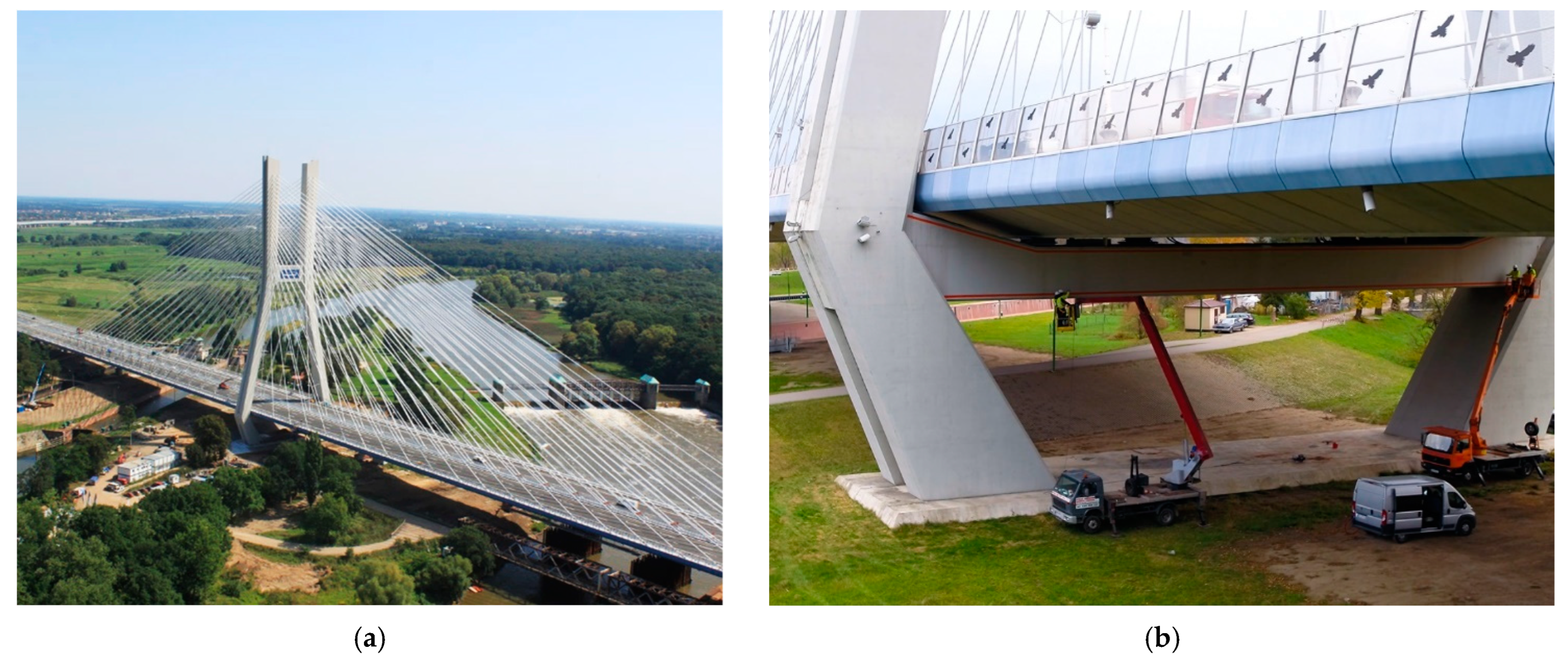

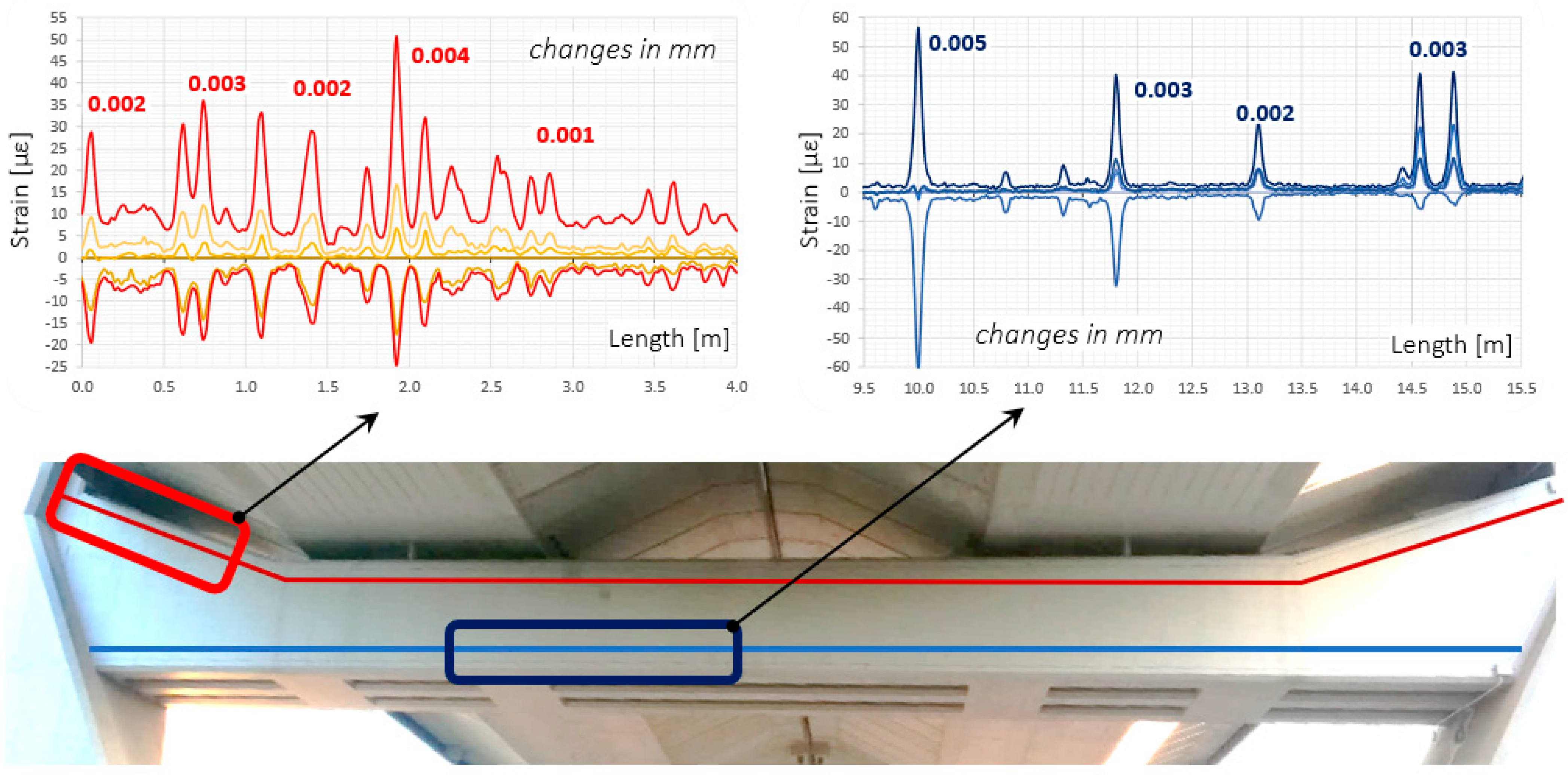


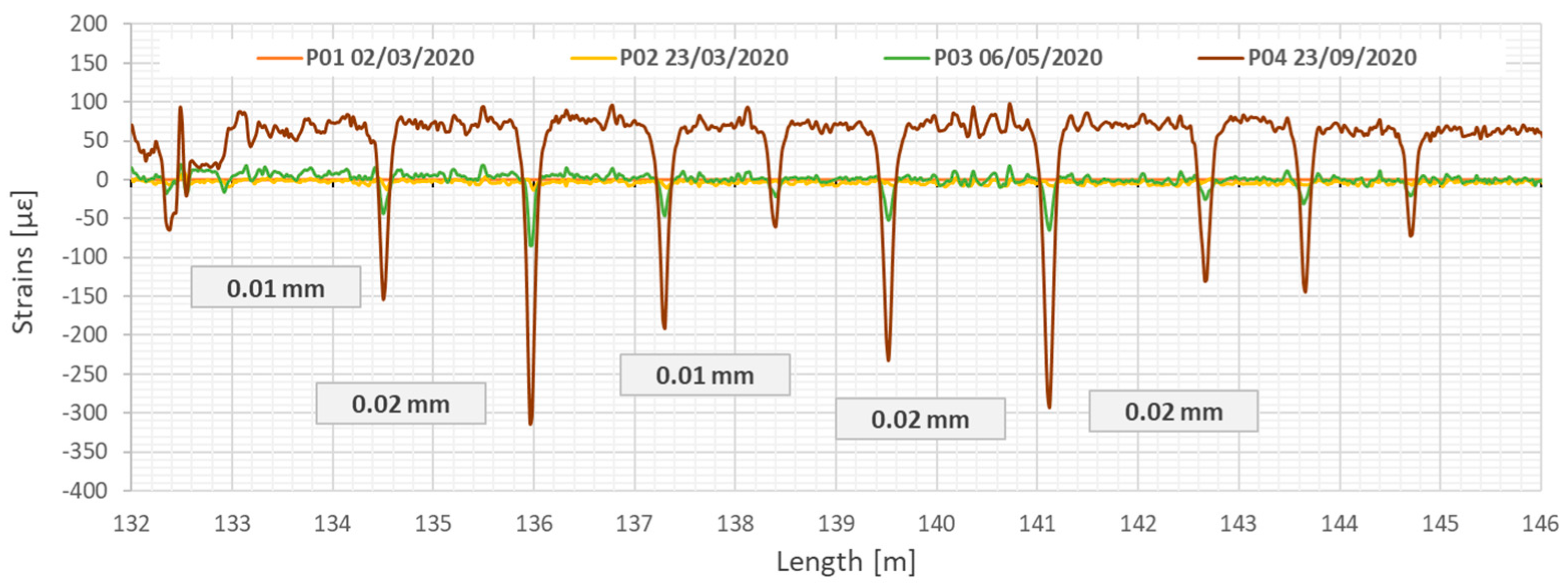
| Parameter | EpsilonSensor | EpsilonRebar |
|---|---|---|
| Strain resolution | ±1 µε | ±1 µε |
| Maximum strain | ±40,000 µε (±4%) | ±20,000 µε (±2%) |
| Standard diameter | Ø3 mm | Ø5 mm |
| Elastic modulus | 3 GPa | 50 GPa |
| Axial stiffness EA | 21 kN | 982 kN |
| Core material | PLFRP (polyester + epoxide) | GFRP (glass + epoxide) |
| Bending radius | 50 mm | 350 mm |
| Sensor weight | 13 kg/km | 45 kg/km |
| Light scattering 1 | Rayleigh, Brillouin, Raman | |
| Delivery method | coils or straight sections | |
| Length | any length made to order | |
| Step | Selection of | Details Considered |
|---|---|---|
| 1 | DFOS technique (Rayleigh, Brillouin, hybrid) | Measurement parameters (spatial resolution, accuracy, strain resolution, distance range, acquisition time, number of channels, etc.). |
| 2 | Monolithic strain sensor | Geometrical and mechanical properties (diameter, elastic modulus, strength, maximum strain, external braid, bending radius). |
| 3 | Installation method | Surface or near-to-surface installation for existing structures (with analysis of the adhesive’s properties). Embedding inside the new structures. |
| 4 | Thermal compensation | Raman technique, hybrid measurements, special DFOS temperature sensors, conventional spot temperature gauges (depending on distance range or expected temperature distributions and changes). |
| 5 | Post-processing algorithms | Data validation, thermal compensation algorithms, strain presentation, crack detection, width estimation, assessment of uncertainties, results visualisation (in length and time domain). |
| Crack | Width (mm) | Diff. (mm) | Diff. (%) | ||
|---|---|---|---|---|---|
| M2 | C2 | Ext. ref. | (M2 − C2) | (M2 − C2)/M2 × 100% | |
| ① | 0.329 | 0.267 | 0.30 | 0.062 | 19.0 |
| ② | 0.548 | 0.351 | 0.60 | 0.197 | 35.9 |
| ③ | 0.451 | 0.318 | 0.40 | 0.133 | 29.6 |
| ④ | 0.409 | 0.309 | 0.35 | 0.100 | 24.5 |
| ⑤ | 0.593 | 0.382 | 0.45 | 0.211 | 35.6 |
| mean | 0.466 | 0.325 | 0.42 | 0.141 | 28.9 |
Publisher’s Note: MDPI stays neutral with regard to jurisdictional claims in published maps and institutional affiliations. |
© 2022 by the authors. Licensee MDPI, Basel, Switzerland. This article is an open access article distributed under the terms and conditions of the Creative Commons Attribution (CC BY) license (https://creativecommons.org/licenses/by/4.0/).
Share and Cite
Bednarski, Ł.; Sieńko, R.; Howiacki, T.; Zuziak, K. The Smart Nervous System for Cracked Concrete Structures: Theory, Design, Research, and Field Proof of Monolithic DFOS-Based Sensors. Sensors 2022, 22, 8713. https://doi.org/10.3390/s22228713
Bednarski Ł, Sieńko R, Howiacki T, Zuziak K. The Smart Nervous System for Cracked Concrete Structures: Theory, Design, Research, and Field Proof of Monolithic DFOS-Based Sensors. Sensors. 2022; 22(22):8713. https://doi.org/10.3390/s22228713
Chicago/Turabian StyleBednarski, Łukasz, Rafał Sieńko, Tomasz Howiacki, and Katarzyna Zuziak. 2022. "The Smart Nervous System for Cracked Concrete Structures: Theory, Design, Research, and Field Proof of Monolithic DFOS-Based Sensors" Sensors 22, no. 22: 8713. https://doi.org/10.3390/s22228713
APA StyleBednarski, Ł., Sieńko, R., Howiacki, T., & Zuziak, K. (2022). The Smart Nervous System for Cracked Concrete Structures: Theory, Design, Research, and Field Proof of Monolithic DFOS-Based Sensors. Sensors, 22(22), 8713. https://doi.org/10.3390/s22228713






